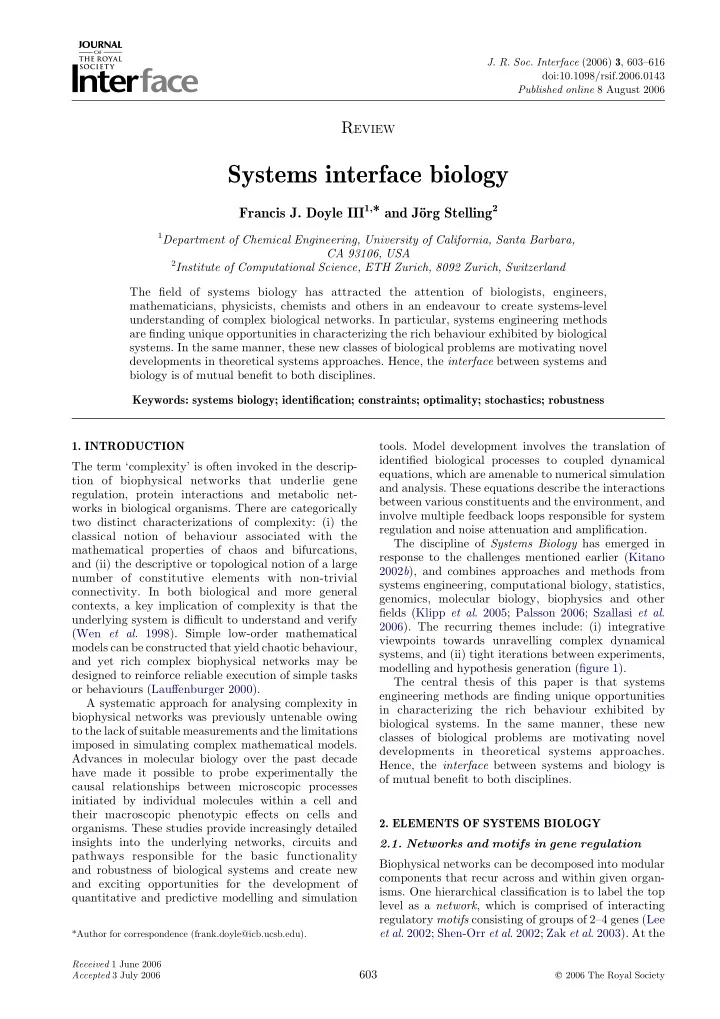

J. R. Soc. Interface (2006) 3 , 603–616 doi:10.1098/rsif.2006.0143 Published online 8 August 2006 R EVIEW Systems interface biology Francis J. Doyle III 1, * and Jo ¨rg Stelling 2 1 Department of Chemical Engineering, University of California, Santa Barbara, CA 93106, USA 2 Institute of Computational Science, ETH Zurich, 8092 Zurich, Switzerland The field of systems biology has attracted the attention of biologists, engineers, mathematicians, physicists, chemists and others in an endeavour to create systems-level understanding of complex biological networks. In particular, systems engineering methods are finding unique opportunities in characterizing the rich behaviour exhibited by biological systems. In the same manner, these new classes of biological problems are motivating novel developments in theoretical systems approaches. Hence, the interface between systems and biology is of mutual benefit to both disciplines. Keywords: systems biology; identification; constraints; optimality; stochastics; robustness 1. INTRODUCTION tools. Model development involves the translation of identified biological processes to coupled dynamical The term ‘complexity’ is often invoked in the descrip- equations, which are amenable to numerical simulation tion of biophysical networks that underlie gene and analysis. These equations describe the interactions regulation, protein interactions and metabolic net- between various constituents and the environment, and works in biological organisms. There are categorically involve multiple feedback loops responsible for system two distinct characterizations of complexity: (i) the regulation and noise attenuation and amplification. classical notion of behaviour associated with the The discipline of Systems Biology has emerged in mathematical properties of chaos and bifurcations, response to the challenges mentioned earlier (Kitano and (ii) the descriptive or topological notion of a large 2002 b ), and combines approaches and methods from number of constitutive elements with non-trivial systems engineering, computational biology, statistics, connectivity. In both biological and more general genomics, molecular biology, biophysics and other contexts, a key implication of complexity is that the fields (Klipp et al . 2005; Palsson 2006; Szallasi et al . underlying system is difficult to understand and verify 2006). The recurring themes include: (i) integrative (Wen et al . 1998). Simple low-order mathematical viewpoints towards unravelling complex dynamical models can be constructed that yield chaotic behaviour, systems, and (ii) tight iterations between experiments, and yet rich complex biophysical networks may be modelling and hypothesis generation (figure 1). designed to reinforce reliable execution of simple tasks The central thesis of this paper is that systems or behaviours (Lauffenburger 2000). engineering methods are finding unique opportunities A systematic approach for analysing complexity in in characterizing the rich behaviour exhibited by biophysical networks was previously untenable owing biological systems. In the same manner, these new to the lack of suitable measurements and the limitations classes of biological problems are motivating novel imposed in simulating complex mathematical models. developments in theoretical systems approaches. Advances in molecular biology over the past decade Hence, the interface between systems and biology is have made it possible to probe experimentally the of mutual benefit to both disciplines. causal relationships between microscopic processes initiated by individual molecules within a cell and their macroscopic phenotypic effects on cells and 2. ELEMENTS OF SYSTEMS BIOLOGY organisms. These studies provide increasingly detailed insights into the underlying networks, circuits and 2.1. Networks and motifs in gene regulation pathways responsible for the basic functionality Biophysical networks can be decomposed into modular and robustness of biological systems and create new components that recur across and within given organ- and exciting opportunities for the development of isms. One hierarchical classification is to label the top quantitative and predictive modelling and simulation level as a network , which is comprised of interacting regulatory motifs consisting of groups of 2–4 genes (Lee et al . 2002; Shen-Orr et al . 2002; Zak et al . 2003). At the *Author for correspondence (frank.doyle@icb.ucsb.edu). Received 1 June 2006 603 Accepted 3 July 2006 q 2006 The Royal Society
Recommend
More recommend